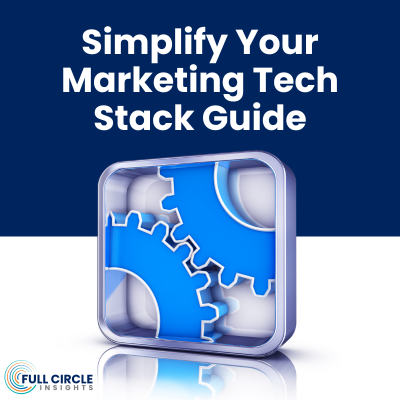David Gillman wrote a great post called Key Marketing Metrics You Should Be Getting From Your CRM. In the post he describes how the CRM system is the best place to get a picture of how your marketing is performing. I couldn’t agree more. The CRM system is where all your customer data is (or should be) gathered including the outcome of every response to every campaign. But the question is not whether we should take David’s advice but how to do it.
In this post, I’ll review all of David’s recommendations (which are good ones, by the way) and show you how you can do it this with the popular salesforce.com CRM and (shameless plug) our products from Full Circle Insights. I’ll include references to blogs and webinars so you you can read about how to do this in more depth.
This blog is going to be a bit of a sales pitch but please excuse me. At Full Circle Insights, we are really passionate about helping marketers get the information they need to do better marketing and make a measurable impact on their businesses. We believe that getting the real data on marketing performance is how marketers “get a seat at the revenue table.”
Ok, let’s get to reviewing David’s blog.
1) Campaign Response Rate is traditionally a very important measurement to get an accurate account of the outcome of every response to your campaigns. Here David describes this metric as “the most difficult task in marketing metrics” particularly when a company has a long relationship with the customer. He also says “CRM data does not solve the problem.” Ah! Not true if you use Salesforce and Full Circle Insights.
Using Full Circle Response Management, you can track the outcome of every campaign response (whether the response is a lead or contact inside Salesforce) and get a complete historical record of every response. With a complete database, imagine the quality of the information you can get about your marketing campaign performance!
Resource: If you want to learn more about how to track the outcome each campaign response, watch the 5 minute response management video which introduces the concept of Full Circle Response Management and shows a short demo.
2) Campaign Influence Rate is also an important metric because it shows the relative value of each campaign based on how much revenue the campaign is influencing. Note that campaign influence is different than how much revenue is sourced by marketing. Rather, since a buyer may respond to multiple campaigns, campaign influence provides a mechanism for taking the total revenue generated and dividing it into a logical way among the campaigns. David says campaign influence is “notoriously hard to calculate outside a CRM system.” I agree! Good campaign influence requires accurate deal information associated with every campaign and the best place to do this is right inside Salesforce.
There are many ways to do campaign influence and Full Circle Campaign Influence has very flexible models that support all these methods. And since there is no standard for calculating campaign influence, you can see the calculations (and all the underlying data) for 3 models at a time and you can customize the models to meet your business needs. Campaign Influence can be purchased separately or as part of Full Circle Response Management.
Resource: To get an acquainted with Campaign Influence, watch our Campaign Influence Best Practices in Salesforce webinar.
3) Lead to Customer Conversion Rate. In David’s blog he writes the “key to this metric is specificity” meaning you want to be able to see this metric based on key attributes such as customer size or industry. With Full Circle Insights, lead to customer conversion rate is just one of the many funnel metrics that are important to understand how your marketing works. Many top marketers subscribe to the SiriusDecisions Waterfall which describes the 5 key stages in the marketing funnel — Inquiry, Marketing Qualified Lead, Sales Accepted Lead, Sales Qualified Lead, and Closed Deal. The newer version of the waterfall includes the role of sales and telesales. Because of this complexity, Full Circle subscribes to the notion that you should want to see the waterfall sourced by each of these different organizations — a separate waterfall for marketing, sales, and telesales. Alternatively, you can view the combined waterfall for the entire company.
Funnel metrics can be really powerful tools to help you understand key demand generation metrics such as volume, velocity and conversion rates across your campaigns, departments, etc. I wrote a blog about this: Why Funnel Metrics are Essential to Marketing Operations which you may find helpful on this topic.
Full funnel metrics are available in Full Circle Insights today and using standard Salesforce reporting features you can slice and dice by any market segment you choose. Many companies like to look at funnel metrics by campaign type or by market size (e.g. small business, mid-range, and enterprise).
Funnel metrics are particularly helpful when working with sales organizations as you can use them to identify inefficiencies in the sales process or leverage the information to identify how to best support the sales team with programs that drive high velocity.
Resources: Check out this Webinar: Align Sales and Marketing with Funnel Metrics to see how funnel metrics can bridge sales and marketing and improve efficiencies.
4) Lead Source Acquisition Rate describes the “quantity and quality of new leads by source” according to David’s blog. Can you get this out of your CRM system? Absolutely. But having reps assigning the lead source to a lead is not the most optimal or accurate way to do this. Full Circle Insights subscribes to a robust use of campaigns in Salesforce so that most of the campaign assignments are automated. Then you can use Salesforce campaign reporting to create reports and get the counts. We also have a feature that allows reps to assign a sales campaign to a lead with a very simple one-click method.
5) Metrics Over Time is mentioned as David’s 5th key marketing metric. He confesses that this is not really a metric but rather showing the trends over time. Because Full Circle Insights keeps track of the historical responses and the outcomes, you can get all sorts of trending information from Salesforce including conversion rate trends, volume trends by funnel stage, velocity trends, influence trends and more!
We strongly recommends setting a baseline of your marketing metrics and measuring them over time.
Resource: For more information on setting a marketing metric baseline see my post Get a Baseline on Your Marketing Metrics.
Summary
As you can see, David’s post has great advice on which marketing metrics you should measure in your CRM system. But it’s not a wish list! You can do this today!
Webinar Series
Secrets of Marketing Ops
What are the secrets of marketing ops? How do they seemingly do it all? Join us for this live webinar to find out.
Wednesday, May 22, 2024
10AM PT, 12PM CT, 1PM ET
What's New at Full Circle Insights
Your Source for Marketing Campaign Attribution, Full–Funnel Measurement, Web–Session Tracking, and ABM Measurement Content



